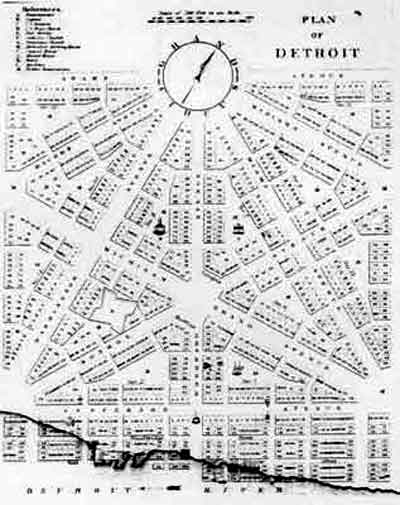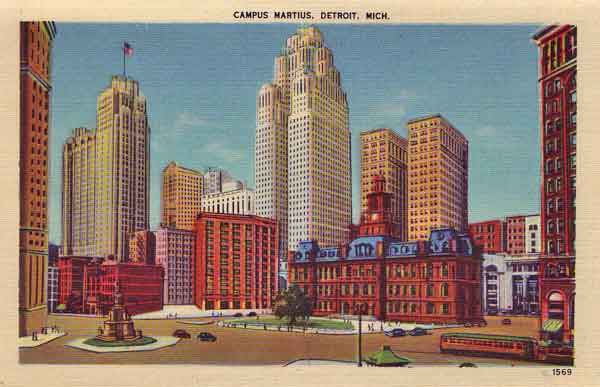

215 woodward's detroit
This is a copy of
Augustus Woodward's original plan for Detroit, and most of its streets
survive in the city center today. To get the full, strange flavor of
Woodward's concept, though, imagine Detroit if the plan had been
allowed to expand naturally, as intended.
The circle at the top with the compass rose is today Grand Circus Park (only a semicircle survived later developers, but it became the heart of the city's theatre and hotel district after 1900). Similar circles can be seen in the lower left and lower right corners. These too were meant to be circular parks, each the center of a hexagonal, cellular unit. Twelve streets would radiate from each. Within the cells, triangular blocks formed the basic unit; space was reserved within these for schools and other public buildings, as shown on the plan. What's it all about? No one knows what Woodward was really thinking, but with the geometrical mania that blossomed with the birth of the United States, it should not be surprising to find a backwoods judge thinking along the same lines as architects of the Italian Renaissance. Perhaps it involved the symbolism of the beehive, a common symbol for prosperity and order in those days (as among the Mormons). Woodward, a former Washingtonian, would already have been familiar with diagonal intersecting boulevards from that city. Augustus Brevoort Woodward was a Columbia graduate, a polymath who once wrote a book entitled On the Substance of the Sun. For a while he served as a Washington city councilman. With some taste for the possibilities of speculation gained there, he lit out West and became one of the first judges appointed to the Michigan Territory in 1805. Nobody really knows how he became such an influential man so quickly, but in the same year Woodward was able to devise and push through a plan for Detroit so surpassingly strange that it holds a place of honor in the world's museum of urban curiosities. Woodward's fights with the early Detroiters were legendary—his surveyor once conspicuously used the only copy of the plan to patch a missing window pane. But for a while at least, he won. Half of a hexagon was actually laid out, and it is the center of downtown Detroit today. Detroiters couldn't stand it. They named their main street after Woodward,then forgot all about him and set to work building the rest of town in a good sensible grid. Ironically, and even in Detroit's current dereliction, Woodward's plan made possible one of America's most visually spectacular city centers, with unexpected vistas around every corner, and Art Deco skyscrapers peering out from every odd angle. The Grand Circus and the Campus Martius* were once among the most urbane public spaces in America, and one day they may be again. 
Such curiosities were few in early America. One that did appear, we owe to relentlessly Cartesian mind of Thomas Jefferson. A syndicate planned a rival to newborn Louisville at the Ohio breaks, across on the Indiana shore. Jefferson was friendly to the syndicate; the new town would be named after him, Jeffersonville, and he in turn designed a plan for it, a grid plan, but with a twist. Jeffersonville would be a checkerboard city: the black spaces built up with houses, the white ones open squares left for parks or for farming. Jefferson always hated cities and the proletarian mobs in them; perhaps a result of his experiences in Paris on the eve of the French revolution. Here, he's doing his best to keep a city from being urban; his stated concerns argued from the angle of public health, not surprisingly in an age overshadowed by epidemics of yellow fever. Jeffersonville never took off, however, and its plan is only a memory. Louisville, Kentucky, which beat out Jeffersonville and grew fat, had an interesting plan itself. In the beginning, it was to be a kind of linear city, three blocks wide, stretching for a half-mile along the banks of the Ohio. Everything outside the strip was common land, for the city to keep or sell off for development as it wished. The opportunities for creative planning were obvious, but like almost every other town that reserved common lands, Louisville simply sold them all off as fast as it could. *Campus Martius. In fact, this square's revival is already underway. A recent redesign, completed with the help of the Project for Public Space, includes chairs out in summer and a skating rink in winter; it's become quite a popular place. There's still a long way to go; some of the surrounding parcels remain vacant, and the composition could use a focal point to replace the demolished Old City Hall. Detroiters might also consider bringing back the lovely fountain by Carrere and Hastings that once stood here, now languishing in a distant city park. |
|

|